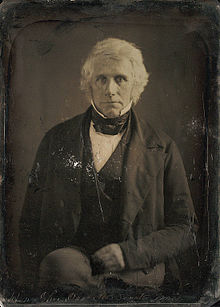John Davis | |
|---|---|
 Daguerreotype by Mathew Brady, March 1849 | |
| United States Senator from Massachusetts | |
| In office March 4, 1835 – January 5, 1841 | |
| Preceded by | Nathaniel Silsbee |
| Succeeded by | Isaac C. Bates |
| In office March 24, 1845 – March 3, 1853 | |
| Preceded by | Isaac C. Bates |
| Succeeded by | Edward Everett |
| 14th & 17th Governor of Massachusetts | |
| In office January 7, 1841 – January 17, 1843 | |
| Lieutenant | George Hull |
| Preceded by | Marcus Morton |
| Succeeded by | Marcus Morton |
| In office January 9, 1834 – March 1, 1835 | |
| Lieutenant | Samuel Turell Armstrong |
| Preceded by | Levi Lincoln Jr. |
| Succeeded by | Samuel Turell Armstrong (acting) |
| Member of the U.S. House of Representatives from Massachusetts's 5th district | |
| In office March 4, 1825 – January 14, 1834 | |
| Preceded by | Jonas Sibley |
| Succeeded by | Levi Lincoln Jr. |
| Personal details | |
| Born | January 13, 1787 Northborough, Massachusetts, US |
| Died | April 19, 1854 (aged 67) Worcester, Massachusetts, US |
| Resting place | Worcester Rural Cemetery |
| Political party | Whig Anti-Jackson |
| Spouse | Eliza Bancroft Davis |
| Relations | Henry Cabot Lodge Jr. (great-great grandson) |
| Children | John Chandler Bancroft Davis, Horace Davis |
| Alma mater | Yale College |
| Occupation | lawyer, politician |
| Signature | |
John Davis (January 13, 1787 – April 19, 1854) was an American lawyer, businessman and politician from Massachusetts. He spent 25 years in public service, serving in both houses of the United States Congress and for three non-consecutive years as Governor of Massachusetts. Because of his reputation for personal integrity he was known as "Honest John" Davis.
Born in Northborough, Massachusetts, Davis attended Yale College before studying law in Worcester, Massachusetts, where he established a successful law practice. He spent 10 years (1824–34) in the United States House of Representatives as a National Republican (later Whig), where he supported protectionist tariff legislation. He won election as Governor of Massachusetts in a three-way race in 1833 that was decided by the state legislature. After two terms he was elected to the United States Senate, where he served most of one term, resigning early in 1841 after he was once again elected governor.
His second term as governor was undistinguished, but he split with fellow Whig Daniel Webster over a variety of issues, and lost the 1843 election to Democrat Marcus Morton. He was reelected to the Senate in 1845, where he served until 1851. He opposed the Mexican–American War, and worked to prevent the extension of slavery to the territories, although he did not take a hard line on the matter, voting for most of the provisions of the Compromise of 1850. He retired from public service in 1853, and died the next year.